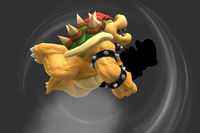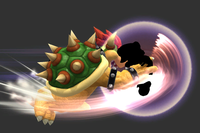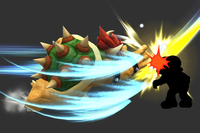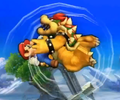Flying Slam
| Flying Slam | |
|---|---|
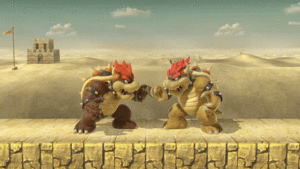 Flying Slam in Super Smash Bros. Ultimate. | |
| User | Bowser Giga Bowser |
| Universe | Mario |
| Article on Super Mario Wiki | Flying Slam |
Flying Slam (ダイビングプレス, Diving Press) is Bowser's side special move since Super Smash Bros. Brawl, replacing the Koopa Klaw in Melee.
Overview
Flying Slam is essentially the same move as Koopa Klaw from Melee on startup: clawing at the opponent. However, the similarities end there: it lacks a hitbox outside of the grab range, and once the grab connects, it automatically transitions to a flying suplex. Thus, there is no pummel like the Koopa Klaw either, and its forward and back throws are also removed. Fundamentally, Koopa Klaw and Flying Slam are very different moves.
During the suplex, Bowser's air movement can be controlled greatly. However, as Bowser and his opponent's percentage difference increases, each player can control the movement. The higher Bowser's percentage, the less control he has.
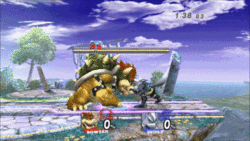
Victims aren't entirely at Bowser's mercy, though, as they can also alter Bowser's horizontal trajectory - whoever has less damage will have more control over Bowser's movement. On occasion, if the Bowser player and another player are falling off stage it may connect, and can be used as a recovery move. Additionally, when he is in the higher control port, Bowser's death after the Bowsercide can be stalled by mashing the jump button while holding the control stick in one side-direction. This will cause him to perform a second jump, not unlike the motion of a shorthop. This can be extended further by using Fortress, and can be used to survive a Bowsercide on stages like Castle Siege (when the stage is about to change) and Norfair (when the lava is at its lowest point).
In Brawl and Super Smash Bros. for Nintendo 3DS versions older than 1.0.4, this move can be used to easily cause a sacrificial KO (commonly known as "Bowsercide"), which is particularly useful against edgeguarders performing a "wall of pain"-style edgeguard. Interestingly, the DOJO!! has stated that if one uses this move to do a sacrificial KO while both are on their last stock, the game would be called in Bowser's favor. However, this only happens when Bowser's controller port is lower (such as Bowser is player 1 and the opponent is player 2), but if Bowser's port is higher, Sudden Death occurs. A common tournament rule gives the victory to Bowser in this situation, regardless of what the game's result screen says, as Bowser is above the player during the move. Others however go by what the results screen states, to avoid conflicts. In 3DS version 1.0.4 and beyond and Super Smash Bros. for Wii U, Bowser would instead get KO'd first, making him lose if he and his opponent are on their last stocks. Additionally, the opponent would also get released after Bowser gets KO'd, giving them the possibility to recover back to the stage. This change remains in Ultimate.
Since foes in the Subspace Emissary cannot be grabbed by special moves, Bowser does not actually perform a flying slam. Interestingly, he merely inflicts damage with his claws, just like the Koopa Klaw did in Melee.
In Super Smash Bros. 4 and Ultimate, Flying Slam can also deal collateral damage to fighters who are caught in the crossfire of the slam. However, this only applies to Bowser's Flying Slam, as Giga Bowser's variation of Flying Slam still lacks any collateral damage properties.
Koopa Hopping
Koopa Hopping is a technique in Brawl that allows Bowser to jump continuously from platforms without the delay of landing. This is achieved by inputting a jump during a Flying Slam just before landing. Hopping increases Bowser's airborne mobility, allowing him to fade in and out with aerials or Flying Slams.
Instructional quotes
| Grab a foe, leap up, and crush them under Bowser's weight. | ||
| Grab foes, jump up, and body-slam them. | ||
| Grabs an opponent, jumps into the air, and then slams them to the ground. |
Customization
Special Move customization was added in Super Smash Bros. 4. These are the variations:
| 1. Flying Slam | 2. Dash Slam | 3. Dash Slash |
|---|---|---|
| "Grab an opponent, jump into the air, and slam them to the ground." | "Dash and grab an opponent. The jump isn't high, but there's more sideways movement." | "Charge and slash opponents with your claws. Low damage, but high launch power." |
- Flying Slam: Default.
- Dash Slam: Dash forward and slam someone with less vertical distance. Does horizontal based knock back, 12% damage, and the ending lag is identical to the regular Flying Slam, although it has somewhat increased startup. If this move is used near a Spring, Bowser and his victim will be pushed a huge distance, about 1/3 of The Great Cave Offensive. Less effective at KOing, but can KO at the ledge due to its lower launch angle.
- Dash Slash: Dash forward and slashes opponents similar to the Koopa Klaw, but without the grab. Bowser goes about halfway the length of Battlefield. The move does 8% damage, has high base knockback (but has almost no KO power), and has low endlag. Flying Slam's complete autocancel property in Smash 4 greatly benefits the aerial version of Dash Slash more than the other variants, allowing for safe approaches and potential combos. If Bowser lands with the move just before the hitbox comes out, he will slide similarly to Melee's wavedash technique, giving him an excellent approach. Since it isn't a grab, it can be punished when shielded properly. If still suffering knockback when using this move, he won't dash as far or at all.
Dash Slam in Super Smash Bros. for Nintendo 3DS
Dash Slash in Super Smash Bros. for Nintendo 3DS
Origin
Bowser has never done a suplex in any Mario game before; however, he does perform a piledriver in Mario & Luigi: Superstar Saga. During a fight where he teams up with Popple, he may execute a "Bros. Attack", where he grabs Popple, throws him into the air, jumps up to catch up, then piledrives Popple directly into the ground, creating multiple shockwaves to attack Mario and Luigi indirectly. Though not identical, this attack shares the same fundamental concept with Flying Slam, being a grabbing move, followed by a jump, followed by a wrestling move, and ending in a hard landing.
The exact manoeuvre of a diving splash looks very similar to how Bowser flies backwards off the spiky bombs if Mario throws him onto one of them and lands on his front in Super Mario 64, not to mention Bowser's ability to jump high back onto the platform if Mario fails to launch him into the spiky bombs.
Gallery
Flying Slam in Super Smash Bros. for Nintendo 3DS.
Flying Slam in Super Smash Bros. for Wii U.
